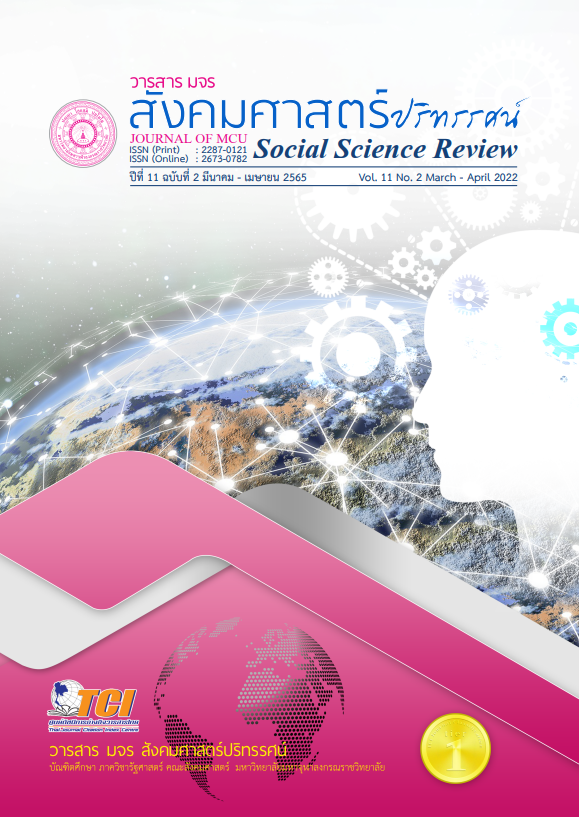การพัฒนารูปแบบการบริหารจัดการศาสนทายาท ของคณะสงฆ์จังหวัดนนทบุรี
คำสำคัญ:
การพัฒนารูปแบบ, การบริหารจัดการ, ศาสนทายาท, คณะสงฆ์บทคัดย่อ
บทความวิจัยนี้มีวัตถุประสงค์เพื่อวิเคราะห์สภาพทั่วไป ศึกษาองค์ประกอบ และ นำเสนอการพัฒนา เป็นการวิจัยแบบผสานวิธี ระหว่างการวิจัยเชิงคุณภาพโดยสัมภาษณ์เชิงลึกกับผู้ให้ข้อมูลสำคัญ 17 รูปหรือคน และการสนทนากลุ่มเฉพาะกับผู้ทรงคุณวุฒิ 10 รูปหรือคน โดยเจาะจง วิเคราะห์ข้อมูลโดยการพรรณนาความ และการวิจัยเชิงปริมาณ ดำเนินการโดยศึกษากลุ่มตัวอย่างจำนวน 148 รูป เครื่องมือที่ใช้ในการเก็บรวมรวมข้อมูลคือแบบสอบถาม สถิติที่ใช้ในการวิเคราะห์ข้อมูลได้แก่ ค่าความถี่ ค่าร้อยละ หาค่าเฉลี่ย ส่วนเบี่ยงเบนมาตรฐาน
ผลการวิจัยพบว่า 1. วัดมีความพร้อมด้านบุคลากร วัดมีความพร้อมด้านสถานที่ มีเวทีในการพัฒนาความรู้ความสามารถ มีกิจกรรมที่เป็นการส่งเสริมศรัทธา มีการควบคุมเรื่องระเบียบวินัยอย่างเคร่งครัด 2. องค์ประกอบที่สำคัญ 2 ประการ คือ 1) องค์ประกอบด้านการบริหารทรัพยากรมนุษย์ 2) องค์ประกอบด้านไตรสิกขา 3. การพัฒนารูปแบบ ประกอบด้วย การปลูกฝักศรัทธาในพระพุทธศาสนาแก่ศาสนทายาทโดยให้มีศรัทธาอย่างแนบแน่น และมีความรักและศรัทธาในพระรัตนตรัย การเพิ่มศักยภาพทางปัญญาให้ศาสนทายาทได้มีความรู้พระปริยัติธรรมแผนกธรรม มีความรู้พระปริยัติธรรมแผนกบาลี และสามารถสอนธรรมะได้ การเพิ่มขีดความสามารถให้กับศาสนทายาทให้มีการพัฒนาตนอยู่เสมอ สามารถเผยแผ่พระพุทธศาสนาได้เป็นอย่างดี และสามารถช่วยเหลือตนเองและผู้อื่นได้ การเสริมสร้างองค์ความรู้ด้านพระพุทธศาสนาให้ศาสนทายาท
เอกสารอ้างอิง
จักรวาล สุขไมตรี. (2557). รูปแบบการพัฒนาทรัพยากรมนุษย์ตามแนวพุทธจริยธรรมระดับอุดมศึกษา (ดุษฎีนิพนธ์พุทธศาสตรดุษฎีบัณฑิต สาขาวิชารัฐประศาสนศาสตร์). พระนครศรีอยุธยา: มหาวิทยาลัยมหาจุฬาลงกรณราชวิทยาลัย.
ณัฐกานต์ บุญแนบ. (2562). การนำหลักพุทธธรรมมาปลูกฝังให้กับต้นกล้าที่เป็นเยาวชนซึ่งเป็นอนาคตของชาติ. วารสารสหวิทยาการนวัตกรรมปริทรรศน์, 2(2), 55-64.
ณัฐชนันตร์ อยู่สีมารักษ์. (2557). รูปแบบการพัฒนาทรัพยากรมนุษย์ตามหลักพุทธธรรมของสถานศึกษาของรัฐ สังกัดกรุงเทพมหานคร (ดุษฎีนิพนธ์พุทธศาสตรดุษฎีบัณฑิต สาขาวิชารัฐประศาสนศาสตร์). พระนครศรีอยุธยา: มหาวิทยาลัยมหาจุฬาลงกรณราชวิทยาลัย.
ธีรศักดิ์ บึงมุม. การพัฒนาจริยธรรมนักเรียนโดยอาศัยกระบวนการบรรพชาสามเณรภาคฤดูร้อน ศูนย์พัฒนาคุณภาพชีวิตชุมชน อำเภอน้ำพง จังหวัดขอนแก่น. วารสารธรรมทรรศน์, 15(1), 148.
บัญชายุทธ นาคมุจลินท์. (2557). แนวทางการพัฒนาศาสนทายาทที่พึงประสงค์ในพระพุทธศาสนา (ดุษฎีนิพนธ์พุทธศาสตรดุษฎีบัณฑิต สาขาวิชารัฐประศาสนศาสตร์). พระนครศรีอยุธยา: มหาวิทยาลัยมหาจุฬาลงกรณราชวิทยาลัย.
ปาริชาติ ธีระวิทย์. (2561). การเสริมสร้างคุณธรรมจริยธรรมสำหรับนักศึกษาระดับอุดมศึกษาในศตวรรษที่ 21. วารสารเทคโนโลยีภาคใต้, 11(1), 37.
พระครูพิศิษฏ์ประชานาถ (ประยูร นนฺทิโย) และคณะ. (2564). การพัฒนาเครือข่ายเยาวชนในการจัดกิจกรรมเสริมสร้างเครือข่าย ลดปัจจัยเสี่ยงตามแนวพระพุทธศาสนา จังหวัดสมุทรสงคราม. วารสารพุทธนวัตกรรมและการจัดการ, 4(2), 69-80.
พระไพศาล พหุสุตฺโต. (2558). วิธีการสร้างศาสนทายาทของพระสายปฏิบัติ ในจังหวัดสกลนคร. วารสารปณิธาน, 11(16), 130.
พระมหาทวี วิสารโท. (2560). การบวชเป็นศาสนทายาทในพุทธศาสนาแบบเถรวาท. วารสาร มจร สังคมศาสตรปริทรรศน์, 6(1), 23-24.
พระราชวรมุนี (ประยุทธ์ ปยุตฺโต). (2545). ทิศทางการศึกษาของคณะสงฆ์. กรุงเทพฯ: มหาจุฬาลงกรณราชวิทยาลัย.
สำนักงานพระพุทธศาสนาแห่งชาติ. (2563). ข้อมูลพื้นฐานทางพระพุทธศาสนา ปี 2562. สืบค้น 19 มิถุนายน 2563, จากhttp://sta.onab.go.th/index.php?option =com_content&view=article&id=349&Itemid= 361
ดาวน์โหลด
เผยแพร่แล้ว
รูปแบบการอ้างอิง
ฉบับ
ประเภทบทความ
สัญญาอนุญาต
ลิขสิทธิ์ (c) 2022 วารสาร มจร สังคมศาสตร์ปริทรรศน์

อนุญาตภายใต้เงื่อนไข Creative Commons Attribution-NonCommercial-NoDerivatives 4.0 International License.
เพื่อให้เป็นไปตามกฎหมายลิขสิทธิ์ ผู้นิพนธ์ทุกท่านต้องลงลายมือชื่อในแบบฟอร์มใบมอบลิขสิทธิ์บทความให้แก่วารสารฯ พร้อมกับบทความต้นฉบับที่ได้แก้ไขครั้งสุดท้าย นอกจากนี้ ผู้นิพนธ์ทุกท่านต้องยืนยันว่าบทความต้นฉบับที่ส่งมาตีพิมพ์นั้น ได้ส่งมาตีพิมพ์เฉพาะในวารสาร มจร สังคมศาสตร์ปริทรรศน์ เพียงแห่งเดียวเท่านั้น หากมีการใช้ภาพหรือตารางหรือเนื้อหาอื่นๆ ของผู้นิพนธ์อื่นที่ปรากฏในสิ่งตีพิมพ์อื่นมาแล้ว ผู้นิพนธ์ต้องขออนุญาตเจ้าของลิขสิทธิ์ก่อน พร้อมทั้งแสดงหนังสือที่ได้รับการยินยอมต่อบรรณาธิการ ก่อนที่บทความจะได้รับการตีพิมพ์ หากไม่เป็นไปตามข้อกำหนดเบื้องต้น ทางวารสารจะถอดบทความของท่านออกโดยไม่มีข้อยกเว้นใดๆ ทั้งสิ้น





